![[Previous]](../../../buttons/fprev.png)
![[Next]](../../../buttons/fnext.png)
DTC P0010: Intake
Engine Oil Control Valve Circuit
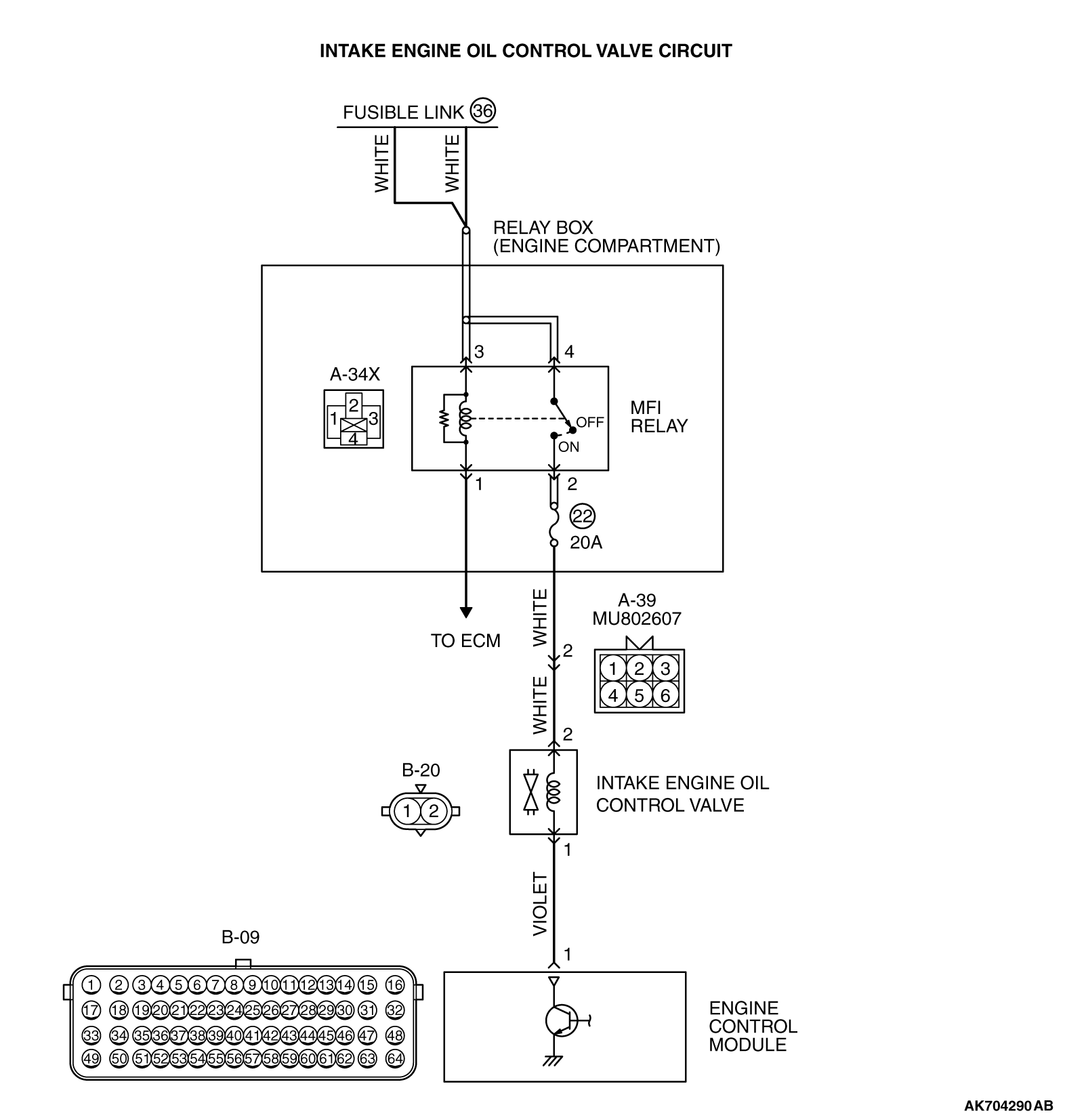
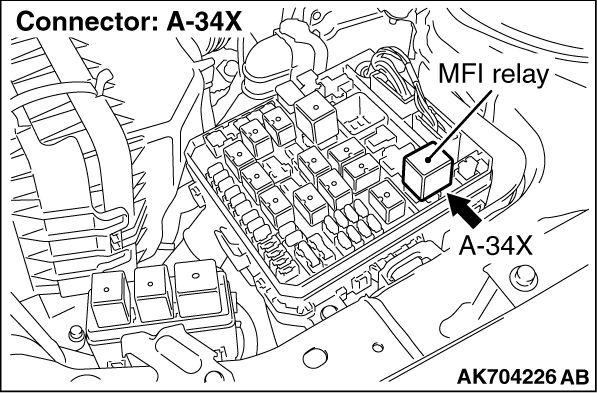
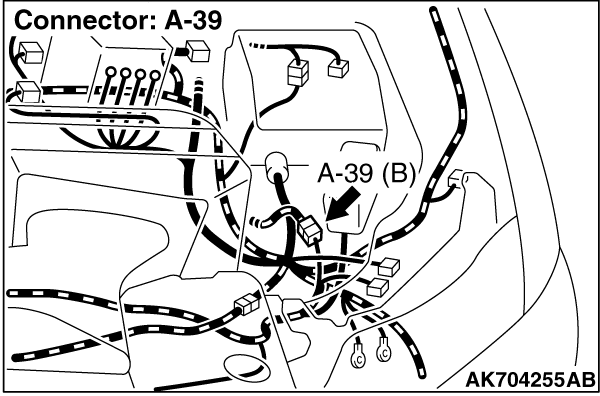
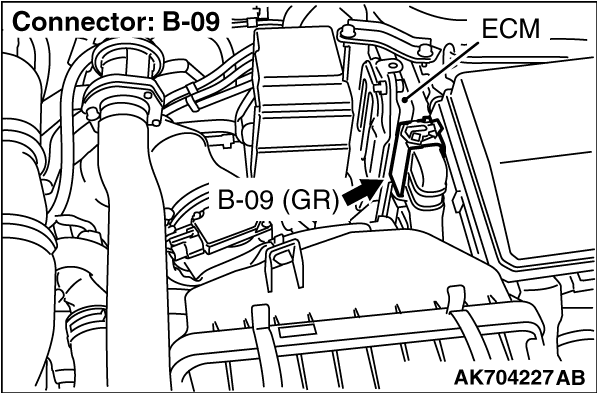

CIRCUIT OPERATION
- The intake engine oil control valve power is supplied
from the MFI relay (terminal No. 2).
- The ECM controls ground intake engine oil control valve by turning the power transistor
in the ECM "ON" and "OFF".
TECHNICAL DESCRIPTION
- The intake engine oil control valve change the phase
angle to operate the MIVEC system in the advance or retard side in accordance with the signals
from the ECM.
DESCRIPTIONS OF MONITOR METHODS
Intake engine oil control valve circuit current is
out of the specified range.
MONITOR EXECUTION
MONITOR EXECUTION CONDITIONS (Other monitor and Sensor)
Other Monitor (There is no temporary DTC stored in memory
for the item monitored below)
Sensor (The sensor below is determined to be normal)
- Camshaft position sensor
- Crankshaft position sensor
- Engine coolant temperature sensor
- Throttle position sensor
- Engine oil control valve
DTC SET CONDITIONS
Logic Flow Chart
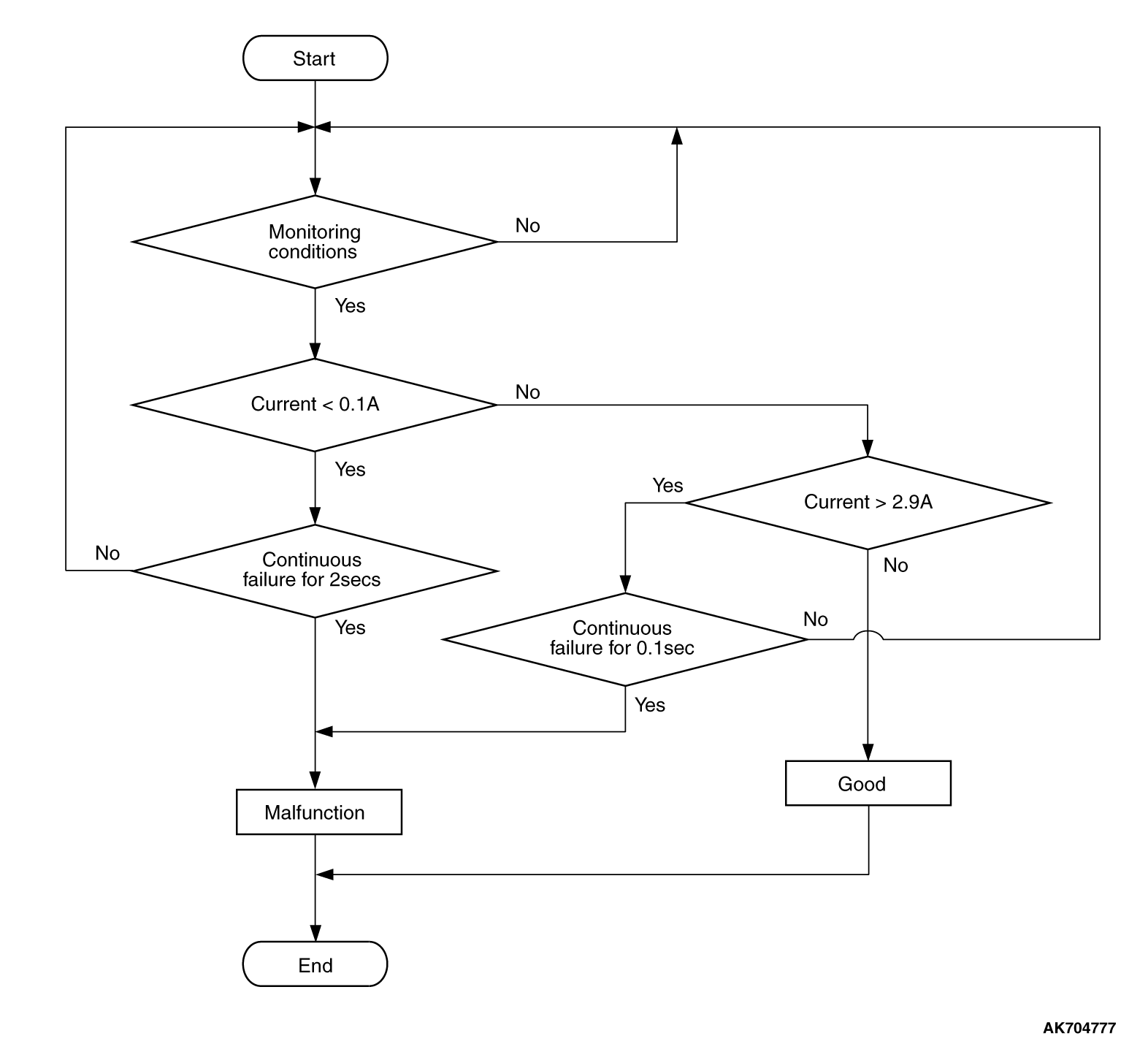
Check Conditions
- Ignition switch is "ON" position
- Battery positive voltage is between 10 and 16.5 volts.
- ON duty cycle of the intake engine oil control valve circuit is higher than 20 percent.
Judgement Criterion
- The ECM terminal current of intake engine oil control valve circuit is less than
0.1 ampere for 2 seconds.
Check Conditions
- Ignition switch is "ON" position
- Battery positive voltage is between 10 and 16.5 volts.
Judgement Criterion
- The ECM terminal current of intake engine oil control valve circuit is higher than
2.9 amperes for 0.1 second.
FAIL-SAFE AND BACKUP FUNCTION
- V.V.T.phase angle (intake) becomes most retarded angle.
OBD-II DRIVE CYCLE PATTERN
Refer to Diagnostic Function - OBD-II Drive Cycle - Pattern
20  .
.
TROUBLESHOOTING HINTS (The most likely causes for this code to be set are:)
- Intake engine oil control valve failed.
- Open or shorted intake engine oil control valve circuit, or harness damage, or connector damage.
- ECM failed.
|
|
Required Special Tools:
- MB992110: Power Plant ECU Check Harness
|
|
|
STEP 1. Check harness connector B-20 at the intake engine
oil control valve for damage.
|
|
|
Q.
Is the harness connector in good condition?
|
|
|
 Go to Step 2. Go to Step 2.
|
|
|
|
|
|
 Repair or replace it. Refer to GROUP 00E, Harness Connector Inspection Repair or replace it. Refer to GROUP 00E, Harness Connector Inspection  .
Then go to Step 10. .
Then go to Step 10.
|
|
|
|
|
|
STEP 2. Check the intake engine oil control valve.
|
|
|
(1)Disconnect the intake engine oil control valve connector B-20.
|
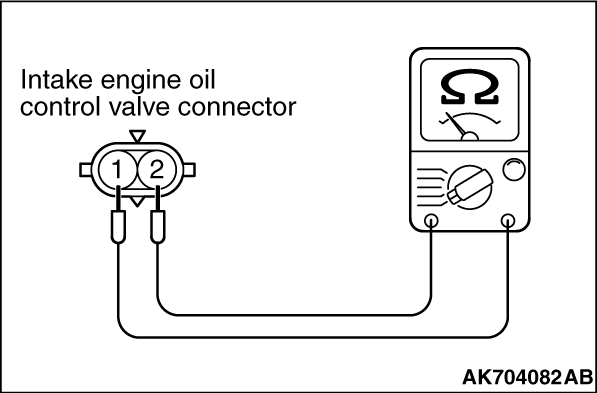
|
(2)Measure the resistance between intake engine oil control valve side connector terminal
No. 1 and No. 2.
Standard value: 6.9 - 7.9 Ω [at 20°C (68°F)]
Q.
Is the measured resistance between 6.9 and 7.9 Ω [at 20°C
(68°F)]?
 Go to Step 3. Go to Step 3.
 Replace the intake engine oil control valve. Then go to Step 10. Replace the intake engine oil control valve. Then go to Step 10.
|
|
|
STEP 3. Measure the power supply voltage at intake engine oil control
valve harness side connector B-20.
|
|
|
(1)Disconnect the connector B-20 and measure at the harness side.
|
|
|
(2)Turn the ignition switch to the "ON" position.
|
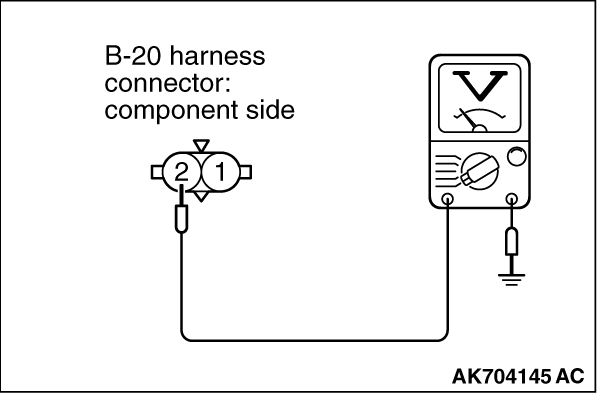
|
(3)Measure the voltage between terminal No. 2 and ground.
- Voltage should be battery positive voltage.
(4)Turn the ignition switch to the "LOCK" (OFF) position.
Q.
Is battery positive voltage (approximately 12 volts) present?
 Go to Step 5. Go to Step 5.
 Go to Step 4. Go to Step 4.
|
|
|
STEP 4. Check harness connector A-34X at MFI relay for damage.
|
|
|
Q.
Is the harness connector in good condition?
|
|
|
 Check harness connector A-39 at intermediate connector for damage, and repair
or replace as required. Refer to GROUP 00E, Harness Connector Inspection Check harness connector A-39 at intermediate connector for damage, and repair
or replace as required. Refer to GROUP 00E, Harness Connector Inspection  .
If intermediate connector is in good condition, repair harness wire between MFI relay connector
A-34X (terminal No. 2) and intake engine oil control valve connector B-20 (terminal No. 2) because
of open circuit or short circuit to ground. Then go to Step 10. .
If intermediate connector is in good condition, repair harness wire between MFI relay connector
A-34X (terminal No. 2) and intake engine oil control valve connector B-20 (terminal No. 2) because
of open circuit or short circuit to ground. Then go to Step 10.
|
|
|
|
|
|
 Repair or replace it. Refer to GROUP 00E, Harness Connector Inspection Repair or replace it. Refer to GROUP 00E, Harness Connector Inspection  .
Then go to Step 10. .
Then go to Step 10.
|
|
|
|
|
|
STEP 5. Check harness connector B-09 at ECM for damage.
|
|
|
Q.
Is the harness connector in good condition?
|
|
|
 Go to Step 6. Go to Step 6.
|
|
|
|
|
|
 Repair or replace it. Refer to GROUP 00E, Harness Connector Inspection Repair or replace it. Refer to GROUP 00E, Harness Connector Inspection  .
Then go to Step 10. .
Then go to Step 10.
|
|
|
|
|
|
STEP 6. Measure the power supply voltage at ECM connector B-09 by
using power plant ECU check harness special tool MB992110.
|

|
(1)Disconnect all ECM connectors. Connect the power plant ECU check harness special
tool MB992110 between the separated connectors.
(2)Turn the ignition switch to the "ON" position.
|
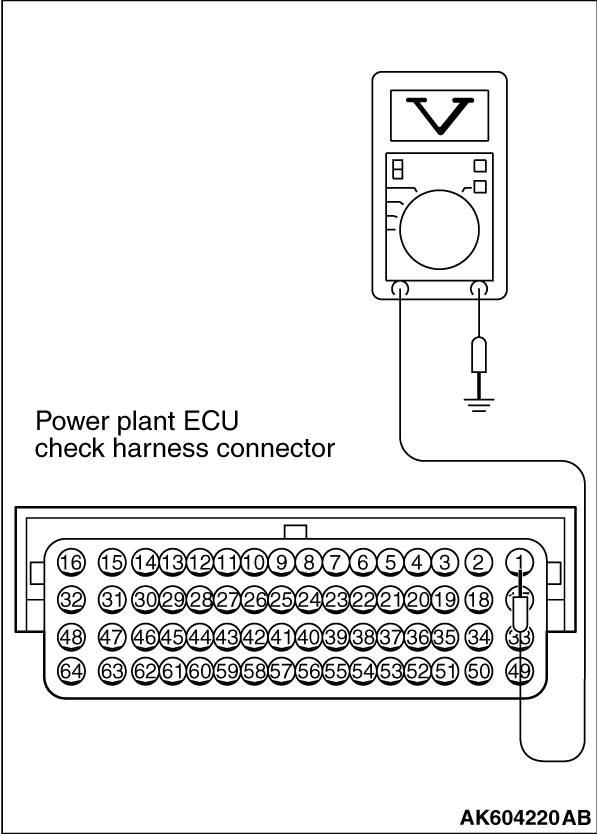
|
(3)Measure the voltage between terminal No. 1 and ground.
- Voltage should be battery positive voltage.
(4)Turn the ignition switch to the "LOCK" (OFF) position.
Q.
Is battery positive voltage (approximately 12 volts) present?
 Go to Step 7. Go to Step 7.
 Repair harness wire between intake engine oil control valve connector B-20 (terminal
No. 1) and ECM connector B-09 (terminal No. 1) because of open circuit or short circuit to ground.
Then go to Step 10. Repair harness wire between intake engine oil control valve connector B-20 (terminal
No. 1) and ECM connector B-09 (terminal No. 1) because of open circuit or short circuit to ground.
Then go to Step 10.
|
|
|
STEP 7. Check for harness damage between MFI relay connector A-34X
(terminal No. 2) and intake engine oil control valve connector B-20 (terminal No. 2).
|
|
|
| note |
Check harness after checking intermediate connector A-39. If intermediate connector is
damaged, repair or replace it. Refer to GROUP 00E, Harness Connector Inspection  . Then
go to Step 10. . Then
go to Step 10.
|
|
|
|
Q.
Is the harness wire in good condition?
|
|
|
 Go to Step 8. Go to Step 8.
|
|
|
|
|
|
 Repair it. Then go to Step 10. Repair it. Then go to Step 10.
|
|
|
|
|
|
STEP 8. Check for harness damage between intake engine oil control
valve connector B-20 (terminal No. 1) and ECM connector B-09 (terminal No. 1).
|
|
|
Q.
Is the harness wire in good condition?
|
|
|
 Go to Step 9. Go to Step 9.
|
|
|
|
|
|
 Repair it. Then go to Step 10. Repair it. Then go to Step 10.
|
|
|
|
|
|
STEP 9. Check the trouble symptoms.
|
|
|
(1)Carry out test drive with the drive cycle pattern. Refer to Diagnostic Function - OBD-II
Drive Cycle - Pattern 20  . .
|
|
|
(2)Check the diagnostic trouble code (DTC).
|
|
|
 Replace the ECM. When the ECM is replaced, register the ID code. Refer to GROUP
42B, ID Code Registration Necessity Judgment Table <Vehicles with KOS> Replace the ECM. When the ECM is replaced, register the ID code. Refer to GROUP
42B, ID Code Registration Necessity Judgment Table <Vehicles with KOS>  or
GROUP 42C, ID Codes Registration Judgment Table <Vehicles with WCM> or
GROUP 42C, ID Codes Registration Judgment Table <Vehicles with WCM>  .
Then go to Step 10. .
Then go to Step 10.
|
|
|
|
|
|
 It can be assumed that this malfunction is intermittent. Refer to GROUP 00, How
to Use Troubleshooting/Inspection Service Points - How to Cope with Intermittent Malfunctions It can be assumed that this malfunction is intermittent. Refer to GROUP 00, How
to Use Troubleshooting/Inspection Service Points - How to Cope with Intermittent Malfunctions  . .
|
|
|
|
|
|
STEP 10. Test the OBD-II drive cycle.
|
|
|
(1)Carry out test drive with the drive cycle pattern. Refer to Diagnostic Function - OBD-II
Drive Cycle - Pattern 20  . .
|
|
|
(2)Check the diagnostic trouble code (DTC).
|
|
|
 Retry the troubleshooting. Retry the troubleshooting.
|
|
|
|
|
|
 The inspection is complete. The inspection is complete.
|
|
|
|
 .
.![[Previous]](../../../buttons/fprev.png)
![[Next]](../../../buttons/fnext.png)






 .
. Go to Step 2.
Go to Step 2. Repair or replace it. Refer to GROUP 00E, Harness Connector Inspection
Repair or replace it. Refer to GROUP 00E, Harness Connector Inspection  .
Then go to Step 10.
.
Then go to Step 10. Repair or replace it. Refer to GROUP 00E, Harness Connector Inspection
Repair or replace it. Refer to GROUP 00E, Harness Connector Inspection  .
Then go to Step 10.
.
Then go to Step 10. Go to Step 6.
Go to Step 6. Repair or replace it. Refer to GROUP 00E, Harness Connector Inspection
Repair or replace it. Refer to GROUP 00E, Harness Connector Inspection  .
Then go to Step 10.
.
Then go to Step 10.
 Go to Step 8.
Go to Step 8. Repair it. Then go to Step 10.
Repair it. Then go to Step 10. Go to Step 9.
Go to Step 9. Repair it. Then go to Step 10.
Repair it. Then go to Step 10. .
. It can be assumed that this malfunction is intermittent. Refer to GROUP 00, How
to Use Troubleshooting/Inspection Service Points - How to Cope with Intermittent Malfunctions
It can be assumed that this malfunction is intermittent. Refer to GROUP 00, How
to Use Troubleshooting/Inspection Service Points - How to Cope with Intermittent Malfunctions  .
. .
. Retry the troubleshooting.
Retry the troubleshooting. The inspection is complete.
The inspection is complete.